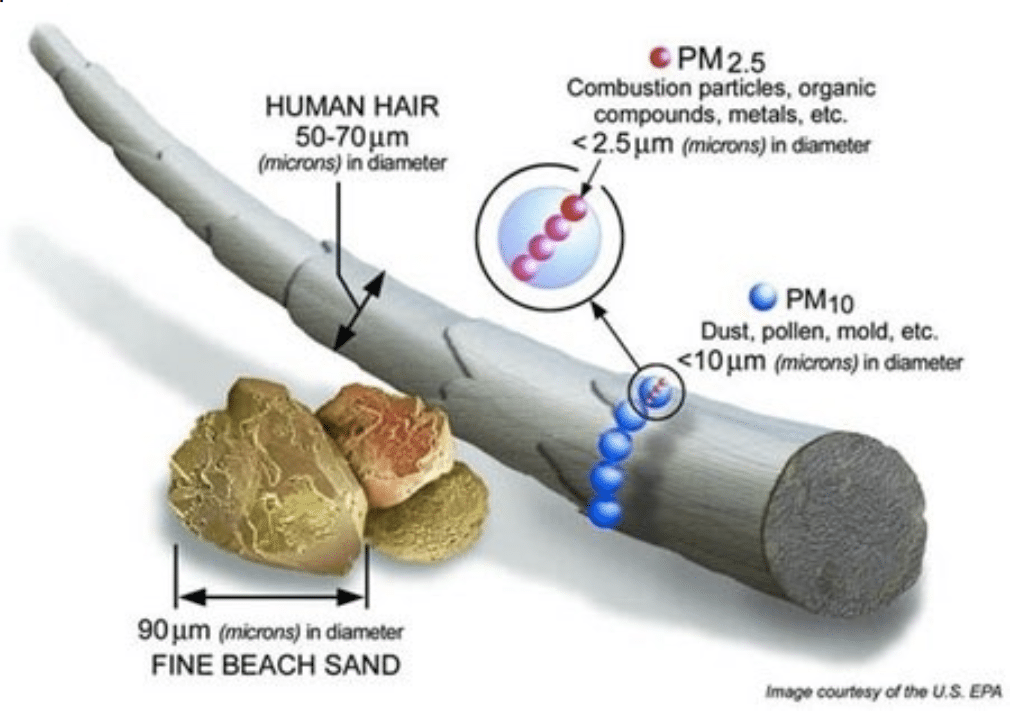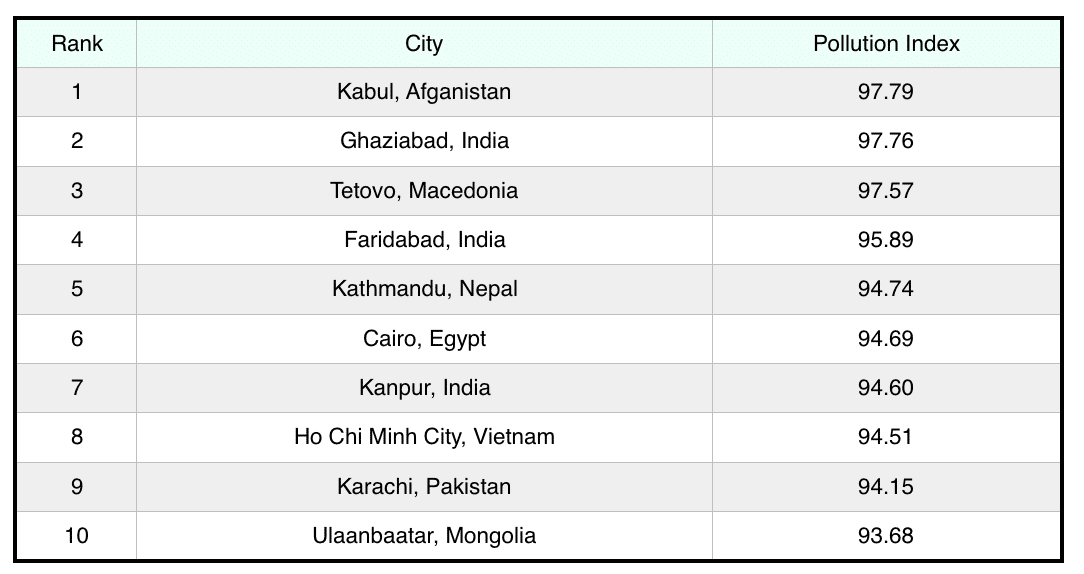6 Things You Need to Know About PM2.5
Although mostly invisible to the naked eye, the air we breathe is full of tiny particles of; chemicals, soil, smoke, dust or allergens, in the form of liquids, gases, or solids. When we burn fossil fuels for energy use and production. The release of gases and chemicals are created air pollution, posing a risk to human health and the planet as a whole. These minuscule airborne hazards are referred to as particulate matter, or PM.
Where does PM come from?
The amount of particulate matter in the air at any given time depends on the environment you find yourself in. These particles are released from a variety of sources both indoors and outdoors. When inside, PM levels are typically the same or lower than outside. Here are a few things that increase the levels of particulate matter floating around an indoor space:- smoking
- cooking
- burning candles or fires
-
- using kerosene heaters
- diffusing essential oils
- cleaning using common chemical products
- opening doors and windows to outdoor polluted environments
- using hairsprays, aerosol room freshers or deodorants
 Although there are hundreds of sources of outdoor air pollutants, the main contributors that increase the levels of particulate matter outdoors are:
Although there are hundreds of sources of outdoor air pollutants, the main contributors that increase the levels of particulate matter outdoors are:
- vehicles
- power generators
- industrial and agricultural emissions
- residential heating and cooking
- the manufacture and distribution of chemicals
- forest fires
Why is it called 2.5?
The 2.5 in PM2.5 refers to the size of the pollutant in micrometres. Bear with us here while it gets a bit mathematics-y! Micrometres have this symbol: µm and are equivalent to 0.001 millimetres. The smallest thing that the average human eye can perceive is about 0.1 millimetres, which is around the same width as a human hair. So in order for us to see something as incredibly small as a micrometre, we need to use powerful microscopes. Here’s a diagram from the Environmental Protection Agency to help you visualize the scale of these tiny particles.  While it is obvious that breathing in any particles in the air is going to aggravate your airways, experts are particularly worried about the extremely small particles such as PM2.5 as they not only penetrate deep into our lungs but are also so minute that they can even pass into our bloodstream.
While it is obvious that breathing in any particles in the air is going to aggravate your airways, experts are particularly worried about the extremely small particles such as PM2.5 as they not only penetrate deep into our lungs but are also so minute that they can even pass into our bloodstream.
What are the negative effects of exposure to PM2.5?
Depending on how healthy you are in general, PM2.5 will have different long and short term negative health effects. When exposed to levels of PM2.5 between to moderate - hazardous range, one may experience the following effects:
- shortness of breath
- eye, nose and throat irritation
- excessive coughing and wheezing
- diminished lung function and lung disease
- diminished heart function, sometimes resulting in heart attack
- asthma attacks
- death

What is considered a safe level of PM and how is it measured?
Pollution levels are generally measured on a scale of 0-500 called an Air Quality Index or AQI: Even at moderate levels, particulate matter can still be harmful to sensitive people. When air pollution levels are lower, the cardiovascular and respiratory health of a person will be much improved, both long and short term. Governments measure levels of PM 2.5 using beta attenuation monitors (BAM), which look like this:
Even at moderate levels, particulate matter can still be harmful to sensitive people. When air pollution levels are lower, the cardiovascular and respiratory health of a person will be much improved, both long and short term. Governments measure levels of PM 2.5 using beta attenuation monitors (BAM), which look like this:  The top tube of the instrument separates the smaller particles like PM 2.5 from larger particles such as PM 10. Just as you suck air through your mouth and into your lungs, an internal pump pulls a large volume of air through the inlet head at the top. The base section of the machine filters the smaller particles down onto the filter tape. Analysts measure the number of particles drawn onto the filter tape and this shows what the level of PM 2.5 is in the surrounding air. The New Hampshire Department of Environmental Services published this picture of PM 2.5 staining the BAM filter tape after a pollution monitoring session. Each circle represents an hour of particle collection. Pretty nasty looking stuff when you imagine it stuck to your lungs not just filter tape.
The top tube of the instrument separates the smaller particles like PM 2.5 from larger particles such as PM 10. Just as you suck air through your mouth and into your lungs, an internal pump pulls a large volume of air through the inlet head at the top. The base section of the machine filters the smaller particles down onto the filter tape. Analysts measure the number of particles drawn onto the filter tape and this shows what the level of PM 2.5 is in the surrounding air. The New Hampshire Department of Environmental Services published this picture of PM 2.5 staining the BAM filter tape after a pollution monitoring session. Each circle represents an hour of particle collection. Pretty nasty looking stuff when you imagine it stuck to your lungs not just filter tape. 
Exactly, how bad is PM2.5 in different parts of the world?
The internet is a treasure trove for real-time data on air quality around the world and there are a few sites such as Berkeley Earth or AQICN, which both show detailed maps describing particulate matter air pollution less than 2.5 microns in diameter constructed from thousands of surface station measurements from around the world. As of the Words Health Organisation’s extensive studies, here is a list of the best and worst nations for air pollution around the world in 2017. All units displayed in this table represent levels of PM2.5. As of 2018 so far, the top 10 most polluted cities in the world might surprise you. Delhi has been bashed in the news frequently for its shocking air quality, but comes in at number 14, with Beijing hot on its heels at number 16. Edinburgh has had some of the clearest air so far this year with an average of 20.23.
As of 2018 so far, the top 10 most polluted cities in the world might surprise you. Delhi has been bashed in the news frequently for its shocking air quality, but comes in at number 14, with Beijing hot on its heels at number 16. Edinburgh has had some of the clearest air so far this year with an average of 20.23.  *Figures were obtained 2018/04/14 via number.com, which is a crowdsourced collaborative global database. Looking at the maps and figures, it is clear that pollution is a global threat which is only increasing in severity. With the World Health Organisation linking over 5.5 million deaths every year to polluted air. So what measures are governments taking around the world to tackle this problem?
*Figures were obtained 2018/04/14 via number.com, which is a crowdsourced collaborative global database. Looking at the maps and figures, it is clear that pollution is a global threat which is only increasing in severity. With the World Health Organisation linking over 5.5 million deaths every year to polluted air. So what measures are governments taking around the world to tackle this problem?
- In London where nearly 10 000 people die prematurely each year due to poor quality air. The government has put in place a decade long low emissions zone. Although the government’s clean air strategy has been criticized as being “toothless and woefully inadequate”.
- China has been bashed as one of the world’s deadliest country’s for outdoor air pollution with calculations that 1.6 million people die each year from breathing bad air. The government has responded forcefully, claiming to “make our skies blue again” by investing heavily in renewable energies and placing population caps on leading cities to prevent “big city disease”.
- Cities from Sao Paolo to Beijing and Oslo have instituted car bans in a bid to halt spiralling levels of carbon emissions from vehicles in urban environments.
- India is ushering in the use of new fuels in a desperate bid to slash its terrible air quality record. The new fuels will have one-fifth the sulphur count of the existing standards, and 1,000 times less sulphur than fuels used in 1995. The measures can’t come soon enough for a country declaring a pollution emergency, wherein the capital the effects are likened to smoking 50 cigarettes a day.
How can I protect myself from PM2.5?
Going inside the house will limit exposure but does not eliminate the risks associated with breathing in PM2.5. Wearing a DIY, mask with removable filters or surgical mask will also not protect you because these masks do not have effective filters for capturing micro-particle. The material and technology used in Cambridge masks make them an effective means of filtering PM2.5. If your environment is a hazard, the best thing you can do to protect your respiratory system from pollutants, viruses, and bacteria is to wear a respirator that provides:- Particle Filtration Efficiency >98%
- Breathing resistance <2 mbar
- Bacterial Filtration Efficiency >99%
- Viral Filtration Efficiency >99%














